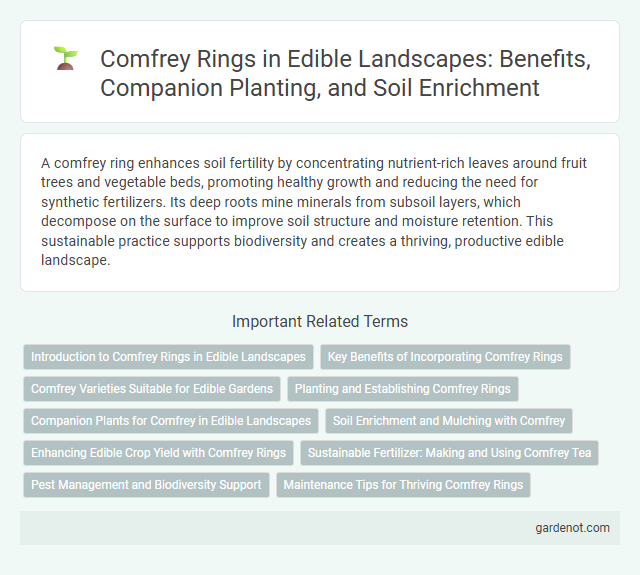A comfrey ring enhances soil fertility by concentrating nutrient-rich leaves around fruit trees and vegetable beds, promoting healthy growth and reducing the need for synthetic fertilizers. Its deep roots mine minerals from subsoil layers, which decompose on the surface to improve soil structure and moisture retention. This sustainable practice supports biodiversity and creates a thriving, productive edible landscape.
Introduction to Comfrey Rings in Edible Landscapes
Comfrey rings serve as a dynamic component in edible landscapes, leveraging the plant's deep-rooted system to mine nutrients and improve soil fertility naturally. Known for its high biomass production, comfrey is often planted in circular formations around fruit trees or garden beds to create nutrient-rich mulch through regular leaf harvesting. This sustainable technique enhances soil health, supports plant growth, and increases overall productivity in permaculture and food forest designs.
Key Benefits of Incorporating Comfrey Rings
Comfrey rings enhance soil fertility by accumulating vital nutrients like potassium, calcium, and nitrogen, which improve plant growth and yield. Their deep roots break up compacted soil layers, increasing aeration and water retention crucial for healthy edible landscapes. Using comfrey rings reduces the need for synthetic fertilizers, promoting sustainable, organic gardening practices.
Comfrey Varieties Suitable for Edible Gardens
Comfrey varieties such as Symphytum officinale and Symphytum x uplandicum are ideal for edible gardens due to their vigorous growth and nutrient accumulation properties. These varieties excel in dynamic accumulator roles, mining essential minerals like potassium, calcium, and magnesium to enrich soil fertility naturally. Incorporating comfrey rings using these species enhances sustainable gardening practices by providing a continuous source of nutrient-rich mulch and green manure.
Planting and Establishing Comfrey Rings
Planting comfrey rings involves selecting a nutrient-rich, well-drained soil area with partial to full sun exposure for optimal growth. Establish the ring by planting comfrey crowns or root cuttings spaced 30-45 cm apart in a circular pattern, ensuring deep watering for root establishment. Over time, the comfrey ring develops dense foliage and deep roots that enhance soil fertility and suppress weeds through nutrient accumulation and mulch production.
Companion Plants for Comfrey in Edible Landscapes
Comfrey thrives when paired with nitrogen-fixing plants such as legumes, which enhance soil fertility and support robust growth in edible landscapes. Dynamic accumulators like comfrey draw up essential minerals from deep soil layers, benefiting companion plants including fruit trees, berries, and vegetables by improving nutrient availability. Planting comfrey alongside herbs such as mint and thyme also aids in pest control and promotes biodiversity, optimizing the productivity and resilience of an edible landscape.
Soil Enrichment and Mulching with Comfrey
Comfrey ring significantly enhances soil fertility by accumulating essential nutrients such as potassium, nitrogen, and phosphorus in its deep-rooted leaves, which decompose rapidly when used as mulch. The thick mulch layer conserves soil moisture, suppresses weeds, and gradually releases nutrients, promoting healthy plant growth. Regular harvesting of comfrey leaves for mulching cycles these nutrients back into the soil, reducing the need for synthetic fertilizers.
Enhancing Edible Crop Yield with Comfrey Rings
Comfrey rings improve edible crop yield by providing a rich source of nutrients through their deep-rooted leaves, which decompose to enrich the soil with nitrogen, potassium, and phosphorus. These nutrient-dense mulch layers increase soil fertility and moisture retention, promoting robust growth in surrounding edible plants. Integrating comfrey rings into garden design supports sustainable, high-yield food production by naturally enhancing soil health and boosting crop productivity.
Sustainable Fertilizer: Making and Using Comfrey Tea
Comfrey rings serve as a sustainable fertilizer source by utilizing comfrey leaves rich in nitrogen, potassium, and phosphorus to create nutrient-dense comfrey tea. This organic liquid fertilizer accelerates plant growth, improves soil health, and reduces reliance on chemical inputs. Regular application of comfrey tea in edible landscapes fosters a self-sustaining ecosystem by recycling nutrients and enhancing soil fertility naturally.
Pest Management and Biodiversity Support
A comfrey ring enhances pest management by attracting beneficial insects such as ladybugs and lacewings that prey on common garden pests, reducing the need for chemical interventions. Its deep roots mine essential nutrients from the soil, improving plant health and resilience, which naturally deters pest infestations. The dense foliage and diverse flowering patterns support local biodiversity, providing habitat and food sources for pollinators and predatory insects throughout the growing season.
Maintenance Tips for Thriving Comfrey Rings
Regularly mulch comfrey rings with organic matter like straw or wood chips to retain moisture and suppress weeds, promoting vigorous growth. Prune old or damaged leaves during early spring to encourage fresh shoots and prevent disease. Ensure consistent watering, especially during dry spells, while avoiding waterlogging to maintain healthy root development.
Comfrey ring Infographic

 gardenot.com
gardenot.com